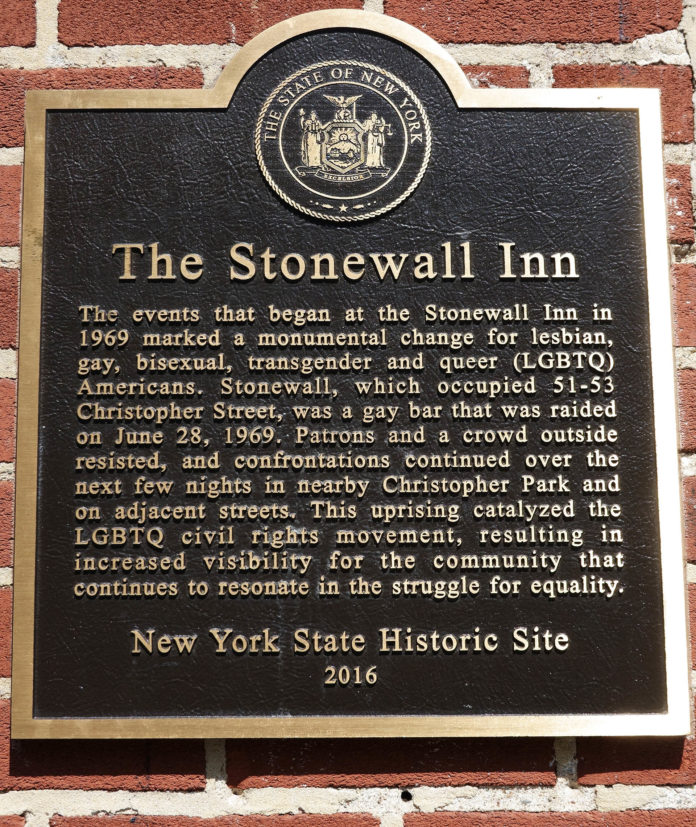“I’m not the only queer person in the beer industry who enters June with excitement and a sense of dread,” says Christopher Shepard, senior editor of Craft Brew News, an industry publication. “You see these posts [on social media from breweries], and it feels kind of nice and it feels kind of hollow.”
Launched to promote awareness and advocacy, Pride Month is a commemoration of the Stonewall Rebellion in New York City on June 28, 1969. In recent years, as June approaches, many breweries wrap beers in rainbow colors and pledge support to LGBTQ+ causes.
Shepard says that truly inclusive operations must donate their time, attention and money “from July to May as well.”
Pride beers are usually available for only a few weeks. Some of this year’s offerings include Kaleidoscope Tropical Witbier, a 4.8% alcohol by volume (abv) beer released by Barrel House Z in Massachusetts. The brewer says that some proceeds will go to BAGLY, a Boston-area group that supports LGBTQ+ youth. Urban South in Louisiana released two new offerings, a beer and a hard seltzer, to celebrate Pride 2021.
Samuel Adams and New Belgium Brewing, two of the country’s largest breweries, teamed for Love Conquers Ale, a 4.9% abv, limited-edition ale. The companies say that all proceeds will go to GLAAD.

Pride beers tend to have modest distribution, but they don’t often languish on the shelves, says Kate Baker, cofounder of Craft Beer Cellar, a beer store in Belmont, Massachusetts.
“Breweries are not brewing a ton of these beers, and certainly, they are not doing it year-round, except Brooklyn Brewery’s The Stonewall Inn IPA, which is pretty awesome,” says Baker. Craft Beer Cellar recently started to sell Banded Brewing’s Here pale ale. Baker says she’s “thrilled” that its label features the transgender flag prominently alongside the Pride flag.
As Baker ticks through several Pride beers available at her shop this year, she notes that their sales tend to mirror year-round craft beer trends. “[It] seems like the gay IPA beers sell better, as would be expected,” she says with a laugh.
Like Shepard, Baker stresses the need for the beer community to support LGBTQ+ causes and individuals beyond June.
“We very much appreciate seeing breweries that make Pride beers make donations to both national and local LGBTQ+ organizations that are meaningful to them and educating their followers about the work they do,” she says. “But, as many of us have learned over the past few years, it’s very important to support marginalized groups all year, beyond special days, weeks or months.”
“There is definitely a level of skepticism within the LGBTQ+ community. We see people throw a rainbow logo up [during Pride], but we need support year-round.” —Alex Showerman, Athletic Brewing
It’s difficult to track how many Pride-themed beers are released annually, or how many of them are regular seasonal offerings.
One of the earliest craft beers released around Pride Month was Sparkleberry, a 9% abv tripel brewed with raspberries by Bells Brewery in 2013. It was designed for the Kalamazoo Pride festival, in the brewery’s hometown.
Sparkleberry was canned and distributed beyond Michigan in 2018, and it remains a seasonal offering. As the beer’s reputation has grown, the brewery has sponsored Pride events in other states.
Brooklyn Brewery’s Stonewall IPA was released in 2017 as a seasonal beer, and it became a year-round offering in 2019. A portion of the proceeds of the beer go to the Stonewall Inn Gives Back Initiative (SIGBI), the company says. While it didn’t share the exact percentage, it estimates it has donated $150,000 to SIGBI since 2017. This year, it plans to sell the beer in international markets like Brazil, France and Sweden.
Virginia Beer Co.’s Friends of Dorothy, a 7.3% abv IPA, is another Pride-focused beer available throughout the year.
“I believe that we are culturally, societally, gaining more competence in knowing what to look for, what questions to ask to determine if a brewery’s intentions are real, if that rainbow logo is backed up 24/7, 12 months of the year with a set of values and actions,” says Shepard. “Right now, it can be hard to tell the difference.”
This point resonates with Alex Showerman, director of JEDI (justice, equity, diversity and inclusion) and NPO (nonprofit organization) partnerships for Athletic Brewing, a non-alcoholic brand based in Connecticut.
“There is definitely a level of skepticism within the LGBTQ+ community,” says Showerman. “We see people throw a rainbow logo up [during Pride], but we need support year-round.”
Athletic Brewing says that all profits from Rainbow Wall, a non-alcoholic, blood-orange IPA created in partnership with Olympian Alex Johnson, go to Athlete Ally, a national nonprofit LGBTQ+ athletic advocacy group.
“That was top of mind for us in creating this beer,” says Showerman. “How are we doing this in an authentic manner, uplifting queer voices, and how are we extending this beyond Pride.”
While Rainbow Wall is a limited-time beer, Showerman says her full-time job is dedicated to breaking down barriers for the underrepresented communities in craft beer and in sports.

Baker suggests craft beer drinkers research breweries to find ones that share their values year-round and in all facets of their business.
“As a consumer, if this support is important to you, you should explore the business to see if that support extends beyond one beer release,” she says. “Hopefully, they also have a culture that supports inclusivity internally with their employees and externally with their customers.”
Many industry people talk about the importance of diversity and inclusion. It can be difficult to determine if concrete actions are behind the messaging.
“If this is just to get my gay dollars, sometimes it’s easy to know, sometimes not,” says Shepard. “The onus is on us consumers to try to figure that out. Do you want my gay dollars July through May, or just want me this month because I party a little more than I do the rest of the year?”
To pander to queer consumers one month of the year is short-sighted, he says.
“I want the answers to the longer-term questions because I spend a lot more money the rest of the year than I do in June.”









